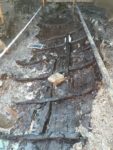 Archaeologists have unearthed a Roman wooden boat on the waterfront of Poreč, a town on the Adriatic coast of Croatia. Beautifully preserved deep in the waterlogged soil, the boat retains rare features, including the “stitches” used to sew the ship together, a technique characteristic of ancient boatwrighting in the northern Adriatic area. Discovered in March at the site of an ancient Roman pier that had been rebuilt in the 1st century, the boat is 16.4 feet long today (it was longer originally) and 5.4 feet wide. It was equipped with a single sail and was likely a small private fishing boat.
Archaeologists have unearthed a Roman wooden boat on the waterfront of Poreč, a town on the Adriatic coast of Croatia. Beautifully preserved deep in the waterlogged soil, the boat retains rare features, including the “stitches” used to sew the ship together, a technique characteristic of ancient boatwrighting in the northern Adriatic area. Discovered in March at the site of an ancient Roman pier that had been rebuilt in the 1st century, the boat is 16.4 feet long today (it was longer originally) and 5.4 feet wide. It was equipped with a single sail and was likely a small private fishing boat.
“It is a Roman sewn ship from the 1st century AD. The technique of sewing the ship is known from earlier periods, from the time of Histra. One of the oldest boats of this type was found at the site of Zambratija near Umag. This specimen from Poreč is one of three boats found on land that are not part of an underwater archaeological survey,” Bartolić Sirotić, an archaeologist from the Regional Museum of Poreč, told Jutarnji list before adding.
“This finding is significant because it is well preserved and has many elements that are very rarely seen. These are primarily the formwork, ribs, and keel. In years, it will be possible to make a preliminary reconstruction of the vessel.” […]
“We are now conducting research. Every stitch that is made is recorded. The sewing technique is such that we have ropes that are tied with rope and sewn through holes that insert wooden nails called spots. And after that, the ribs, which are connected with this plate by the big wooden nails, are put on,” Bartolić Sirotić adds.
The town was built on a tiny peninsula jutting out of the west side of the large Istrian peninsula. Its harbour is naturally protected by the island of Saint Nicholas, making it an ideal location for military defense and for maritime trade. It began as a castrum, a Roman military fort, built in the 2nd century B.C., becoming an official city under Augustus in the 1st century B.C.
The excavation at the intersection of the city waterfront with Cardo Maximus Street is a salvage operation in advance of redevelopment. Once the excavation and in situ investigation is complete, the ship remains will be removed for conservation and the site flooded to create a revitalized, pedestrian-friendly waterfront. The wood will be gradually desalinated in a water bath at the National Museum of Poreč until it is stabilized. Experts will study the structure of the wood as they desalinate and clean it. The water will then be removed, either by replacement with PEG or freeze-drying. The conserved ship will then go on public display at the Poreč Museum.